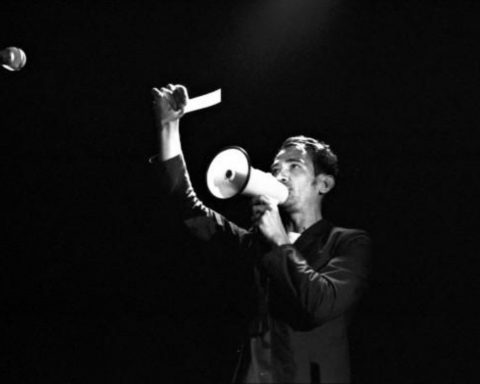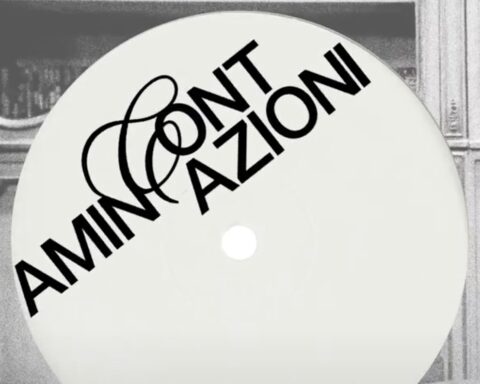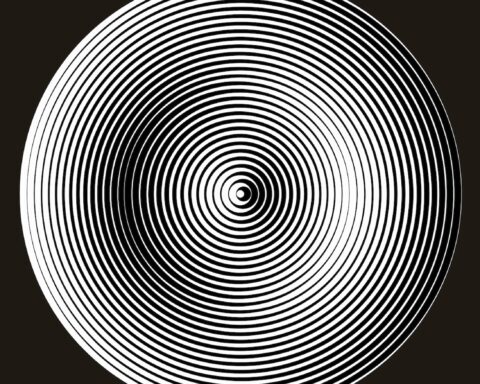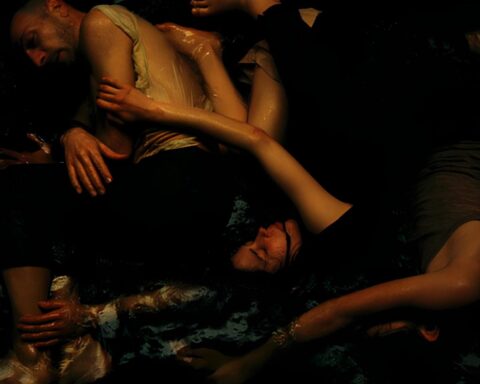The work of French poet and multimedia author Laure Gauthier presents a path capable of renewing the dialogue of rejection against poetry or its negation. In a desire to rethink the voice in all its components, the poet dialogues with other fields of expression and creation, as well as with contemporary research. Seeking to reinvent ways of being with the voice through the profusion of poetry, Gauthier undertakes various intermedial and transmedial collaborations with artists from the arts of image and composers, to awaken the language and ask questions of violence through the voice. Against any reduction, she questions poetry through a work of translation and transfer from his re-writings to other creative fields, notably music. So Laure Gauthier tries to dialogue with what sets writing in motion through different reading devices, because the text is designed to be habitable as a potency and not as a closed linguistic form.

Laure Gauthier with Anna Clementi et le Choeur Spirito
Back into nothingness, TNP de Villeurbanne, 2018. Photo William Garrey
Coral Nieto Garcia: When did you start to wonder about the voice, its nature and its audio-sensitive capacities? Has your research evolved over time?
Laure Gauthier: Although born and currently living in Paris, I spent my childhood in the countryside and the radio played a major role in my life, especially as a teenager. At the beginning, it was the radio voice that prompted me to question the voice more drastically. This plunged me into my first deep questions on the status of the voice, on its origin, on the live or deferred voice, on the sound work accompanying the voice, but also on the voices in the interviews, on the fact of having the voice without the image. When I lived in Germany, I heard a lot of poetic radio creation, readings too. The arts in which absence is heard particularly appeal to me; the soundtrack in the cinema, too, has always given me a lot because it beckons to a world that is often off-screen. There are sound images in the absence. I like the tensions, the questions that result from it. It is about this movement.
Most often, it is my writing that leads me to reflection and then, I dig deeper into these questions. In my books, I write from sort of little soundtracks emanating from the world, more exactly, from what is hidden, a kind of off-camera/ « off-song » (hors chant) of the world. I intuitively work on the gap between the voices, whether it be the plurivocality of Kaspar de pierre (La Lettre volée, 2017), or the voices of Villon, « Villon et ses autres » in Je neige (entre les mots de Villon) (Lanskine, 2018), or else the work on an address to another in Les Corps Caverneaux (Lanskine, 2022). This work written on the voice marks a position of vigilance, a call to observe the tensions present, not to resolve them, nor only to dialectize them: the voice is what crosses reality and puts us in the presence of its complexity, sometimes threatening, sometimes reassuring. There are some voices before the book, some come through the book, others come after the book. There is always a round trip between thought and intuition. Sometimes a question arises from reality: this is the case for what I call my « transpoems »: I recorded « at random », repeating fragments of texts in many contexts (forest, museum, bathroom, coastline, café terrace, etc.) without knowing where I was going; sort of situationist litanies, intuitively following questions that I only knew how to formulate after the fact. So, it was through the voice, by saying these texts in different contexts, that the meaning deviated, rearticulated. Spontaneously. It was when I was composing the album Eclectiques Cités (Acédie58, 2021), published in book, CD and libretto form, that I knew what questions my voice raised about crossing urban, natural, intimate or public spaces.
Of course, then in pedagogy (the « Poetry and music » seminar that I led at IRCAM from 2017 to 2020, or creation workshops etc.) as in essays (From one lyricism to another, MF, 2022) I take steps to the side, I go to another slope, to change the focal length and to deepen certain reflections. There is no relation of equivalence between my poetic writing and my research, but undeniably there are, more or less (un) consciously, reciprocal exchanges.
C.N.G.: For several years you have been carrying out poetic collaborations of an intermedial and transmedial nature with the field of contemporary music, in particular experimental and electroacoustic music. How do you think, as a poet, that literature can reinvent itself in this way?
L.G.: I have collaborated and still collaborate with artists from contemporary music such as Fabien Lévy, Pedro Garcia Velasquez, Núria Giménez-Comas, François Paris, Xu Yi or even Sofia Avramidou and Olivier Mellano.
My writing is not hermetic to other arts, from cinema to dance to music. The influence of film off-field as well as voice-over is important in my writing, but frequenting contemporary music in its immense diversity (electroacoustic, spectral, tonal, atonal, mixed music, but also rock, blues, jazz, punk… or electronic music) renews my listening to the world, allows me to seek in writing to express the « soundtrack » of the world, to perceive the voices that emerge from it differently. In Les corps caverneux (LansKine, 2022), it is about the music of our holes and our empty spaces that the consumer society fills with purchases, images or food. To each of our holes corresponds a music which helps us not to let ourselves be buried. To straighten the head and the body: the music of the caves, the music of the clouds, etc. At the end of the book, I imagine an installation entitled « desire of clouds », a long poem-installation where we would say words of our desire, words that we never dared to say: these words of desire refer to different clouds, cirrus, stratus or cumulus, the types of desire being associated with physical types of clouds. I write these clouds, I invent a poetry of our holes, of our desire for clouds. Writing invents density, timbre, texture. And these pages are an invitation to artists to imagine the space, the sound, the texture of this « desire of clouds ». It will also become an installation with Núria Giménez-Comas.
So, this is not a one-way street. Dance, music, transmedial installations move the lines of my writing. In return, poetry also lays stones in other people’s gardens and invites dialogue beyond the hedge of « disciplines ». Not only do I often write from music, from sounds, real or fictitious, but I also believe in inventing this music that I can only trace in writing. This invites collaborations where we can jointly design a common horizon, a territory, temporalities, and imagine a work by taking each step aside.
C.N.G.: How can poetry affect the different ways of relating to time and space?
L.G.: The important thing is that the medium of language, by itself, by the fact that it is symbolization via an alphabet, moves us differently through space and time, by an abstract prism: and we need these passages to stay creative and open. It is the political dimension of poetry, in the strict sense: it makes us able to live in society if we make the effort to cross complex temporalities, spaces-times that escape us, if language makes us to roam the space and the time otherwise. Unlike the biopic, or the psychologizing novel, poetry advances above all not by a story, or by characters or psychology, but by the language itself which moves. Even if it is to say the present of a body, of a desire or of a fight. This crosses us and forces us to change our focus or to draw on other sources, and therefore to find other resources. It is in the arrangement of space and time that I have tried to show how much Kaspar Hauser is a representative fact of our bourgeois society. It was to put it back in motion, to tear it away from myth and chronicle, while building on it. I invented a journey that Kaspar goes through: street, diagnosis, abandonment, house, etc. For my book, Je neige (entre les mots de Villon) (LansKine, 2021) also, starting backwards with exile says something essential and I maintain its course between the biography and the work, in an in-between moving. My latest book Les corps caverneux plays a lot on circular space-times, the cloud, the cave, and opposes them to rectilinear space-times: the corridor, the shopping arcade, the street…. In this sense, I have a great affinity with the cinema of Werner Herzog which opposes, in all his fiction films as in his documentaries-fiction, the circular time of non-Western societies or of past societies, to the rectilinear, rational time of Western societies. This question of the tension between rationality and irrationality rests today, in a society which has gone very far, too far, in the excess of ratio, but which cannot either risk the irrational, which oscillates between two possible relapses into barbarism: these tensions hold us, force us to move forward, to invent vanishing points without repeating. Poetry gives that a language. Take part in this movement of regeneration, of questioning other possible ones.
C.N.G.: What questions do you find in common between the contemporary French poetic and acousmatic music composers?
L.G.: I find it hard to answer. The fact that acousmatic music produces music while stealing its origin, creates an imagination that plays on presence and absence, and this is close to poetic writing, this tension between an anchoring that is both very concrete and very abstract. I would not like to generalize on « parallelisms », but I think that there are sometimes common questions about the search for other links between space and time, in the knotting of the two, in the relation to the real as well. I can only take a cautious example that concerns me: in «house» 1, 2 and 3 in Kaspar de pierre (La lettre volée, 2017), I develop a very concrete universe, a sound and tactile universe, close to the art povera, it is about the « sounds of the wet, of the basin », I create there both concrete and abstract space-times, and it is in this direction also that I started to collaborate with Pedro Garcia Velasquez for his Études pour théâtre acoustique (2018) where it is about concrete sounds captured in 3D and then musicalized. This listening to reality, to lost places, then this reworking from this material, borders on poetic questions.
C.N.G.: Do you think that technology makes it possible to develop an extension of the voice in a continuum between the body and the technology, in other words, a voice creating relationships between the different elements that constitute it, and as a counterpoint to Western dualist thought?
L.G.: I also think that poetry, whether written or sound, performed or read, can already help us find a continuous movement, to find our tempo of thought as the formula Patrice Loraux, our primordial rhythm as Fernand Schirren suggests, or even our singular rhythm as Henri Meschonnic thinks. All the arts are founded on reality, with or without technique, to breathe new life into, this continuum between body and thought, so as not to fall into a dualism opposing one to the other.
Technology is certainly one of the means of accentuating these passages, these openings, it allows us to experience this continuity and the multiplicity of links between thought and the body. When I think of the installation that I am preparing with the composers Pedro Garcia Velasquez and Augustin Muller, Remember the future (2022), it is obvious that the fact of being able to install my voice in natural places, in leaves of trees for example, with the possibility of giving the voice recorded in the studio parameters of the places recorded, transporting it to natural or urban places, gives materiality to the voice and to the text, which accompanies this movement of writing. The voice of the text traverses these lost places of the composer, experiencing them: the technology and the ambisonic sound system extend the idea of movement of the text, the listener will be able to experience the materiality of the text even more, his sensitive thoughts.
Writing also allows such a continuum, but through a more abstract medium, through the filter of writing. Nevertheless, poetic writing is mobile, it is versatile, full of morphoses: in Kaspar de pierre my language passes from the point of view of the cloud, to that of stone, to embodied thought. Technology can make these notions sensitive. Thus, in Back into nothingness, the rewriting of kaspar for the composer Núria Giménez-Comas, technology has shifted the subject and indeed allowed an accentuation of the voice in the continuum, but not only: the addition of a choir as a mass sound, the presence of three voices, voice over and voice in, to play on the gaps in Kaspar, but also the games on sound images, concrete (stone, wind…) and abstract sounds came to imitate the presence of Kaspar. The spectator’s sound immersion also made it possible to feel Kaspar’s « voices », the threat hanging over him, as well as the very physical and concrete character present in his voice. The play on the sound off and sound in, the amplification, and the ambisonic system allow playing on enveloping sounds, very present and are an important asset for exploring certain aspects of my poetry.
C.N.G.: In these times, it is possible to observe a trend which is interested in realism, both for its material and audible aspect, as much in the plastic, visual, musical and scenic arts. Do you think that this trend is capable of preserving the referential scope (symbolic and mimetic) of the world? If so, with what means?
L.G.: The Dadaists have already problematized this relationship between art and reality and the possible confusion between the two, the need to subvert artistic practices by seeking contrary postures and affirmations, and thus they foreshadowed the whole of the 20th century.
We are in a period of major economic, social and ecological crisis, and as in any period of crisis, artists must confront reality more. It all depends on what we call « real » and « realism », the latter being an «effect of reality». If you want to talk about a certain tendency which consists in wanting supposedly to duplicate the real, to seek to make a consensual art, for example to seek in poetry to speak like the majority, to swallow the roughness and the formal work in the he hope of being better understood or of selling more is a dead end and, in my opinion, it is politically dangerous. I think it is an avatar of capitalism to want to erase what could resist the petrifying systems and the diktats of the consumer society. Art should neither be escapist nor attempt to disappear, merge with the object. It is important that artists allow side steps, movements, to change scale, focus, point of view, to maintain tension. An art that would renounce its symbolizing dimension would risk not showing or hearing, reading, the complexity of reality, its off-camera elements, its complex temporalities, its dangers, its forgotten, its repressed, its beauties otherwise: by looking the imprints, the traces, by listening differently, by looking elsewhere, the artistic work makes it possible to return to reality its depth of field, but also all that is played there and that requires the artistic time which is a plunge into the complexity of the real. I am talking about crossing the real, about « trans-realism »: a movement that allows coexisting and complex realities to be put in motion and in tension. It is best by not claiming to « be the real », but by confronting it, by probing it, by working on the perception, its modification, that one can hope to change side and point of view, to move. That we can also make people aware of the gaps, the tensions that are playing out, and remain vigilant. The danger would be at one point to look only for works that are close to us to dull our senses. We also have to challenge otherness and displacement. It seems to me that we must systematically look for the vanishing point, the position of discomfort, the one that transgresses the language.
C.N.G.: In your opinion, why is there an urgent need to rethink the voice by focusing more on its sonic and material qualities, and less on its semantic character?
L.G.: There was the « prima la musica », and the opposite already. We went a long way when it came to the lied and the French melody in intelligibility. Then we blew up semantics in favor of phonemes.
Today some composers defend the return to intelligibility. It depends on the project. In my plurimedial works, there are tensions between what beckons towards song, can go towards music and shed intelligibility, and on the contrary what holds « together ». I do not believe that we need a fixed position on this point. In our time, which is very normative and even conservative, the singular language of each individual is reduced: it is a major attack to transform us into consumers unable to name the tensions that play out in us or outside us. The attack is so savage that it seems urgent and essential to me to react poetically, to propose resistant languages, poetic and political. So it also matters to me, what I do in transpoems, that we forget the physical qualities of the voice, to listen to what it has to say. That is my job.
In my poetic readings or performances, intelligibility is central. On the other hand, in my multimedia work, I seek with the other artists involved, to maintain the intelligible- unintelligible tension, to make heard the fragility of the language, of what it says. It is important that it also drains the out-of-scope of meaning, which is deaf or inarticulate. And why not also resonate with voices chosen for their sound quality, voices like landscapes that suggest more than they say. But it depends on the project of course. So for the project I am currently writing, I am working on a poetic piece Remembering clouds for Sofia Avramidou which will be created on September 3rd 2022 in Royaumont, and I am writing for Nuria Giménez-Comas Une clarière quand même, which will be created by 2022 for the CIRM (Nice), I am writing for two voice-overs, it will be that of the poet composer David Christoffel and mine, and a solo voice. This will speak and go as far as singing in German, a voice whose meaning will partly escape, and whose sonic qualities are primary.
C.N.G.: Can you tell us about your current creations? I heard about the next project Remember the Future (2022) with composer Pedro Garcia Velasquez. In this kind of collaboration, where are the edges between poetic creation and sound performance ?
L.G.: The installation Remember the future continues the work of Études pour théâtre acoustique composed by Pedro Garcia Velasquez and Augustin Muller. I had started this research, consisting of confronting lost, inaccessible places, captured in 3D, recomposed, and installing a voice saying texts in this device. My voice then dialogue with that of Benjamin Lazar reading Perec, while I read in German fragments of texts. This installation was created at the ZKM in Karlsruhe in September 2019. Since then, Pedro and I have thought a lot about what it means to integrate my text, my voice, also the different temporalities and what this raises as questions for the listener. We are designing this installation, which will be created at the Center Césaré CNCM in Reims from March 2022, as « acoustic naps ». Listeners will be able to lie down, be blindfolded or wear Inuit glasses, and travel through these spaces, traveling through space and time. My voice carries other temporalities, other spaces, speaks of corridors, caves, cave music. In real time, automata instruments created by Pedro will remind us of the present time. We then want the people who have had this experience to write to us which places have appeared, what images have been imposed on them, what temporalities have been evoked. It is a question of seeing all the movements, all the imagination that the co-presence of poetic and musical space-times in a global installation, thought out and conceived together: for the composer this allows us not to remain at «perfection» of the technical gesture, of its ambisonic, and for me, that means making the poetic crossing palpable and audible. There is undeniably a performative dimension to this.
Une clarière quand même, for which I am currently working with Nuria Giménez Comas, is a miniature tale, like a radio tale by Walter Benjamin, “The Glass Heart”. Another piece, “Les tournesols noirs”, is under construction and will be created in Spring 2023. From January 2022, I have started doing performative readings with Olivier Melano. A reading-concert will take place on April 19 2022 at the Maison de la Poésie in Paris. Again, theire is a performative dimension to the work.These passages of voice, these movements, these side steps, nourish the movement of my work.








